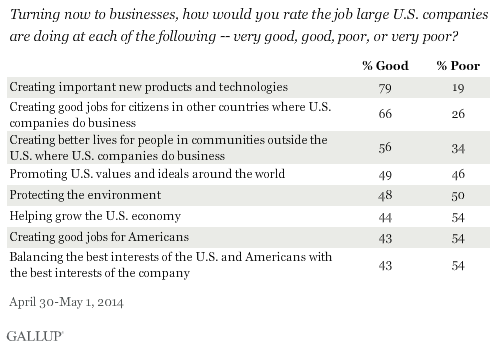
1 Jun, 2014
Americans Say U.S. multinationals do poor job helping grow U.S. economy
PRINCETON, N.J. — (Gallup Polls) May 27, 2014 – Americans see large U.S. companies as having a more positive effect overseas than they do domestically. While 66% of Americans believe that large U.S. companies do a good job creating good jobs for citizens in other countries where they do business, far fewer, 43%, say the companies do a good job of creating jobs for Americans.

These data are based on a Gallup survey with 1,005 U.S. adults conducted April 30-May 1.
Americans in general have a less-than-stellar image of “big business,” with just 22% in previous polls saying they have “a great deal” or “quite a lot” of confidence in big business. This is one of the lowest confidence ratings of any of the institutions Gallup has tested. Americans’ poor ratings of the effectiveness of large U.S. companies in creating U.S. jobs could be one of the underlying reasons for this overall negative image.
Americans do seem to recognize that large U.S. companies contribute in some areas. Americans are most positive about large companies’ ability to create important new products and technologies. But the other two areas in which the majority of Americans give large companies “good” ratings both have to do with their contributions overseas: creating jobs for citizens of other countries and creating better lives for people in communities outside the U.S. where U.S. companies do business. These are the only three issues of the eight tested on which more than half of Americans rate the job that large U.S. companies are doing as “good.”
Americans are roughly split on how well large U.S. companies promote U.S. values and ideals worldwide and the job they do protecting the environment.
The American public rates large U.S. companies less positively on the remaining three areas tested, which all relate to these companies’ domestic contributions. These include helping grow the U.S. economy, creating good jobs for Americans, and balancing the best interests of the U.S. and Americans with the best interests of the company.
Clearly the public is skeptical of the benefits provided by America’s large companies for their home country or the people therein — even while conceding that these organizations create new products and technologies and help the countries overseas where they operate.
Small Is Better Than Big
Previous research shows that 65% of Americans have a great deal or quite a lot of confidence in small business, contrasted with the 22% who have confidence in big business. Asked in the current survey whether big businesses or small businesses make the greater contribution to developing new products and technologies in the U.S., Americans again prefer small over big by 60% to 35%, respectively. Even though Americans rate large U.S. companies positively overall for their creation of new products, they get much less credit on this dimension when compared with small businesses.

Implications
Large U.S. companies clearly have an image problem. A majority of Americans perceive that large U.S. companies do a poor job in terms of creating jobs domestically, helping grow the American economy, and putting the interests of the country ahead of their own.
Thus, one significant challenge large U.S. companies face in their efforts to improve their image at home is convincing Americans that they are the backbone of the U.S. economy as much as they are economies overseas.
Demonstrating their economic contribution domestically compared with small businesses is another challenge. Americans have a positive image of small businesses and give them more credit than big businesses for creating new products and technologies in the U.S. To counter this perception, large businesses clearly need to document the degree to which they are behind many of the innovations and products that grow the U.S. economy. They also need to remind the public that growth among large companies usually leads to development in the small businesses that supply them and that small businesses gain when large companies increase workforces.
Interviews are conducted with respondents on landline telephones and cellular phones, with interviews conducted in Spanish for respondents who are primarily Spanish-speaking. Each sample of national adults includes a minimum quota of 50% cellphone respondents and 50% landline respondents, with additional minimum quotas by time zone within region. Landline and cellular telephone numbers are selected using random-digit-dial methods. Landline respondents are chosen at random within each household on the basis of which member had the most recent birthday.
Samples are weighted to correct for unequal selection probability, nonresponse, and double coverage of landline and cell users in the two sampling frames. They are also weighted to match the national demographics of gender, age, race, Hispanic ethnicity, education, region, population density, and phone status (cellphone only/landline only/both, and cellphone mostly). Demographic weighting targets are based on the most recent Current Population Survey figures for the aged 18 and older U.S. population. Phone status targets are based on the most recent National Health Interview Survey. Population density targets are based on the most recent U.S. census. All reported margins of sampling error include the computed design effects for weighting.
In addition to sampling error, question wording and practical difficulties in conducting surveys can introduce error or bias into the findings of public opinion polls.
View survey methodology, complete question responses, and trends.
For more details on Gallup’s polling methodology, visit www.gallup.com.



Liked this article? Share it!